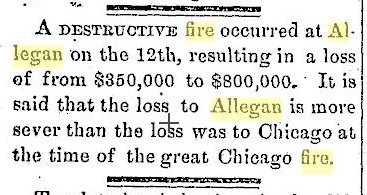 |
The Tragic Allegan Fire of 1884 Articles, Photos and Information |
 |
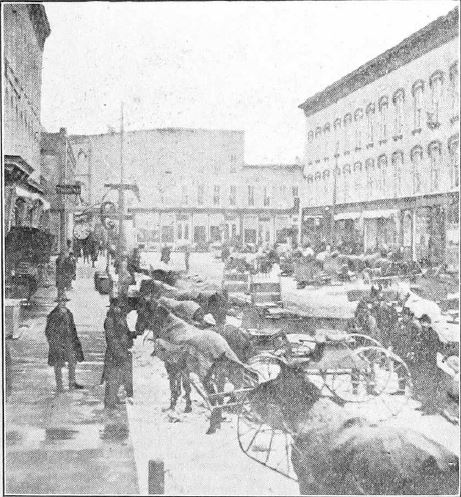
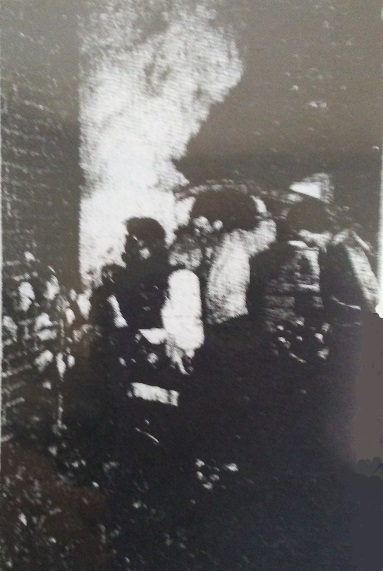
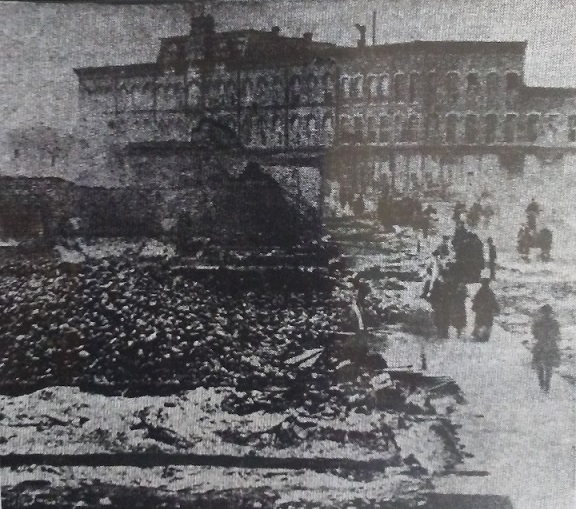
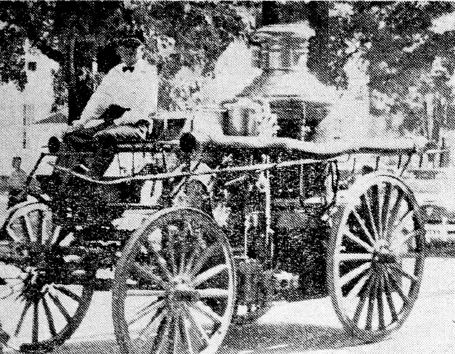
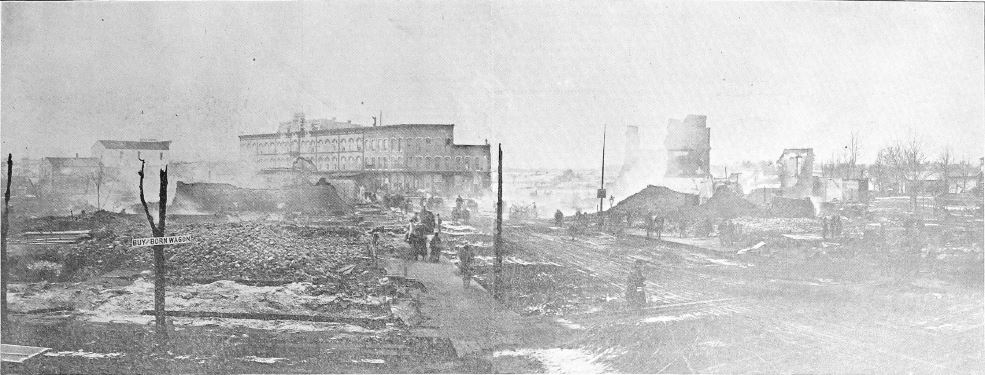
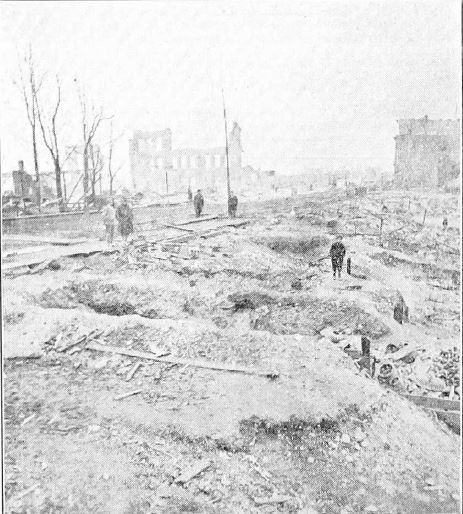
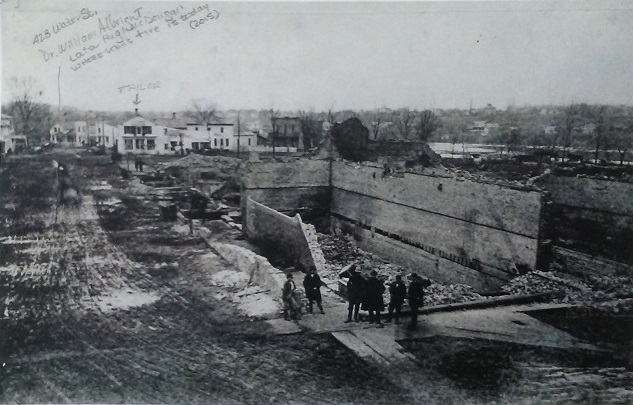
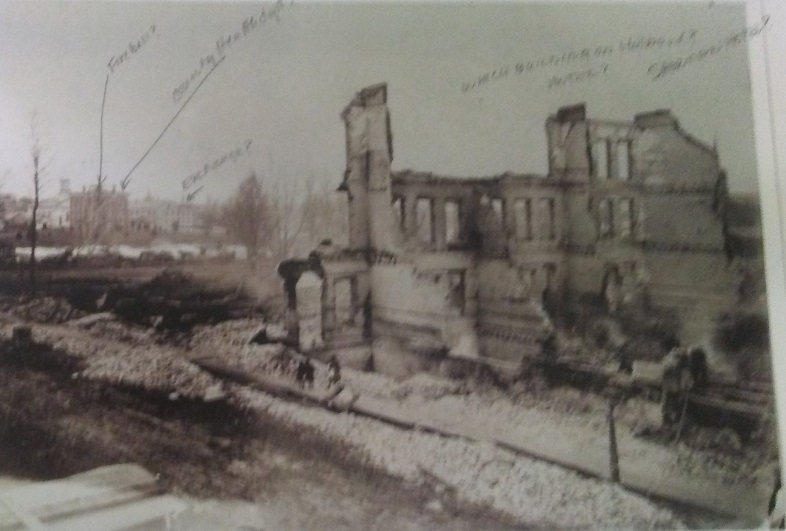
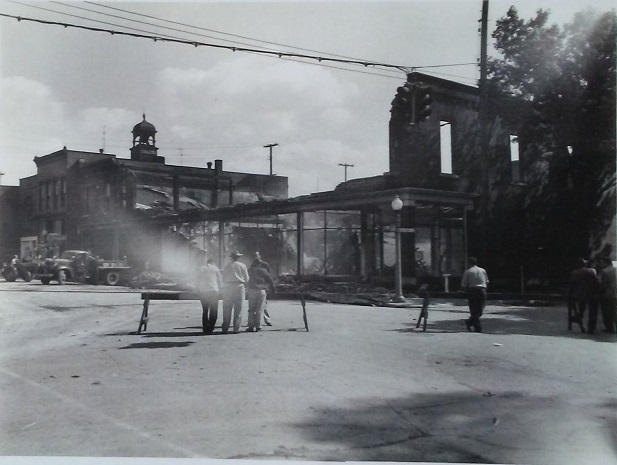 |
The following information is from The Allegan Gazette, Saturday, March 13, 1909 Isabella County Enterprise - 3/19/1884 Half Million in Property is Destroyed Four Acres of Broken Brick and Smoking Cinders Five Brick Blocks and Thirty Wooden Structures Consumed Insurance to Amount of $200,000 From Court-house to the river, from Hubbard-st. to Trowbridge-st., there is not even a wall standing. The magnificent brick and stone blocks which on Wednesday morning lined either side of Locust-st. were swept away in less than two hours, and nothing is left to suggest what had been there except smoldering piles of bridk and stone. The fire originated in the building occupied by I.O. Hoffman and Dr. A.G. Goodson, on Hubbard-st., and was discovered about half-past eleven o'clock. The theory of its origin is that by the settling of a part of the double building an opening had been made along the ridge-pole, from the front of the building about half its length, and a spark from the chimney fell into the opening. This building was at the western end of a row of nine wooden structures on the south side of Hubbard-st., all old buildings, with loose shingles and in good condition for readily catching a fire. The alarm was sounded at half-past eleven, but before the hose could be attached to the hydrant the whole upper part of the Hoffman block was in flames and beyond hope of saving. The wind was blowing a gale from the southwest, sweeping the flames down and across Hubbard-st., but the brick buildings on the opposite side of the street were thought to be safe. A general rush was made by the occupants of the wooden row, to save what they could from the doomed buildings, and merchandise of every kind was quickly carried to what was supposed to be places of safety. For a few moments the air was full of flour-bags, papers of every kind, half-burned shingles, and cinders of every size, which were blown hither and thither by the wind, which increased in power with the fire.f Everything movable was hurried by willing hands to the sidewalks on Locust-st. and the alley running between the Sherman house and Empire block, and there left, as it was supposed, out of the reach of the flames. But the security was but little better than if the stock had been left in the already buring buildings. When it became known that the fire was in rookery row a general feeling of satisfaction was manifest, and expresion was freely given to the face that "now we will have some better buildings there". There did not seem to be an idea that the brick blocks on Locust-st. would so quickly follow the tinder-boxes on Hubbard-st. But a few minute after the alarm was sounded the fire had leaped across Hubbard-st. and caught the Sherman house. A general panic seized upon everyone when it was known that the Sherman house was burning, yet there were still a few people who hoped the fire would not reach beyond that building; but the majority of the Locust-st. merchants began to hurry out their stock and get it beyond the line of danger if such place could be found. By general consent the yard west of the Kellogg building on Trowbridge-st. was accepted as a safe ground, and this space became quickly filled with a motley throng of people carrying every conceivable article. Houshold goods and groceries, tinware and drugs, clothing and wall-paper, pianos and type, crockery and false hair, boots and butter, anything and everything portable was hustled into the vacant space, while men, women, and childred vied with each other in their efforts to save something. Immediately after the Sherman house caught fire, while yet some of the merchants believed the buildings on Locust-st. would be saved, the old Dumont building, a block from the Sherman house, caught fire in the rear end under the eaves. There was no longer hope of saving any of the buildings in the block, and a general stampede ensued-the one idea being to get out whatever was of most value. Within an hour of the outbreak of the fire Empire block [the Sherwood & Griswold corner] was in flames, and before the next hour passed the stone walls of Union block [east side of Locust-st.] had falled in, and the damage had all been done. From the east side of Locust-st. to the river the fire encountered nothing to impede its progress, the few wooden buildings in Water-st. being fat morsels for the hungry flames. It is almost impossible to trace the progress of the fire. In fact, there was no progress-it was a leap, a rush, a roar, and all was over. Less than two hours elapsed between the alarm and the time when the flames had reached the Kalamazoo river at the north, and had nothing more to feed upon. The roar of the fire was terrific, but its speed was marvelous. Sheets of flame filled the air and were blown about by the ocean. Where once the fire obtained a foothold it was impossible to stay its rapid speed. The flames not only burned, they devoured. Everything withered before them, like leaves before the blast of the sirocco. Walls of brick and stone stood no longer than those of wood, but seemed to shrivel and fall a the first onset of the fire. S.S. Dryden's building, on the corner of Locust and Hubbard-st. was a mere wooden shell, yet it stood until after the brick walls of other buildings had fallen, and was one of the very last to go. There was ample time given, in comparison with others, and th Drydens took advantage of it to save a good deal of stock. When the stock was moved from the wooden buildings on Hubbard-st. the greater portion of it was piled in the alley back of Empire block and on the sidewalk on Locust-st., so that when the fire crossed the street from the place of its origin there was plenty of inflammable material for it to feed upon. One theory of the quick destruction of Empire block, is that, while piling goods in the alley, one of the rear windows of the Sherwood & Griswold store was broken and thus gave an entrance to the flames, which were fiercely driven before the wind, but in the face of the fact that the second story was buring before the lower part caught, this theory falls to the ground. One of the most inflammable articles the fire met in its course was the "fire-proof" roof of the Sherman house barns, which blazed and crackled like so many fireworks and furnished additional evidence of the inutility of fire-proof buildings. Still more peculiar was the fact that when the Dumont building caught fire the agent for some patent fire-extinguisher was present with a species of hand-grenade which was thrown upon the fire. They worked most beautifully. Whenever a grenade struck, a fresh flame would shoot up and burn more fiercely than before. With these patent extinguishers any fire-proof building could be destroyed in a few moments. The burning of the Dumont building did more toward creating the panic that ruled for about two hours than andy other one thing. With that on fire, the Empire block, Dunning's drug store, and the National bank block were hemmed in, and in order to save material or goods it was necessary to run the gauntlet of the fire. Many people hurried through the streets carrying bundles from which smoke was rising, they having caught fire while passing the Dumont building. From the start the fireman did most excellent work, but their cause was almost hopeless. When it became evident that the fire could not be confined to the buildings on Hubbard-st., attention was immediately directed to saving such buildings as seemed exposed. Once ignited, it was more than useless to try to save the Sherman house or Empire block, but there was some hope for the Peck block and the Chaffee house [site of present Masonic temple]. Under the leadership of O.T. Booth, hose was got upon the roof of the Chaffee house, from which vantage ground a contant stream was kept pouring upon the side and rear walls of that block adjoining. In the work of saving those buildings, and to these exertions their safety is due, Mr. Booth was efficiently assisted by A.F. Howe, Anning R. Peck, Wilsey Streeter, James Branch, Frank Fenn, and several others whose names it is impossible to learn. Clark Collins [fire chief] was everywhere, doing all that lay in his power, but the fearful couflagration evidently appalled him. He felt the inability of the firemen to cope with the flames; the immensity of the work to be done and the futility of attempting to do it, must have been apparent to him, and the very sight of it must have unnerved him. We do not wish to be understood as saying anything against Collins, but merely to show the uselessness of the efforts of the firemen to stay the flames when once started. But what could be done they did, and from the outbreak of the fire they worked, with all the energy of which men are capable until exhausted. More than one of their number was injured by falling wall or flying cinders, and one, Wilsey Streeter, was so nearly suffocated that he had to be carried to some place of safety for resuscitation. Too much credit can not be given them for their tireless work and their almost total disregard of self when duty required of them some hazardous piece of work. Shortly after the alarm was sounded appeals were made to neighboring places for aid. Plainwell sent her Halcyon hose company, and Holland and Kalamazoo each sent an engine, which arrived too late to be of great service. After the damage had been done a steam engine with Assistant Chief Engineer John Krats in charge and seven men arrived from Muskegon. They came as quickly as telegraph could call and steam get them here, but so rapid had been the work of destruction that there was no fire in business blocks left to extinguish. There were many curious incidents, though fortunately but few accidents, connected with the fire. One of the first facts to be related on the street was to the effect that S.H. Beecher had insured his stock about twenty minutes before the fire broke out. That Charlie Adams had been consulting with H.F. Marsh about insurance on his stock, in the morning, but had failed to complete the arrangement and the fire caught him unsecured. That George T. Lay's clerk [Charles Spears] stood in front of his store shouting, "There is no use moving the stock out: the building can be saved," while the entire upper portion was in flames. That when the hose was brought to the hydrant on Sherwood & Griswold's corner no wrench could be found which would fit the coupling: and after the coupling was made there was not enough water to fill the hose. That, by threes, the rum-shops are going up in smoke. The fire last Thanksgiving day morning destroyed three of these holes and Wednesday's fire swept away three more of them. There is but little hope, however, that they will not be reopened. That, when the saving of goods is in question, ladies can and will render most efficient help, as was demonstrated by the work done in saving Charlie Adam's stock. That, when such a fire, or in fact any fire, breaks out, it is useless to expect any concerted action from the mass of people, who are eager to help but lack the knowledge of what is best to do and how to do it. Few people, unaccustomed to scenes of great excitement, could face the disaster of Wednesday without losing the presence of mind, and it is a matter for wonderment and congratulation that so much was saved from the general ruin. Concerted action, with some person with experience as leader, might have led to much better results; but, everything considered, the outcome is most excellent. Fires are very damaging and much more previlent in the past than today. Allegan, unfortunately experienced a second major fire. Not as costly as the fire of 1884, but the fire of 1895 caused considerable damage. On Wednesday, December 4th, 1895, U.S. Smith was the first to find the fire that started in the elevator shaft in the finest structure in the village, the Chaffee block. The article in The Allegan Gazette on Saturday, December 7, 1895 explaines the fire of 1895 clearly. |
 Return To Home Page
Return To Home Page